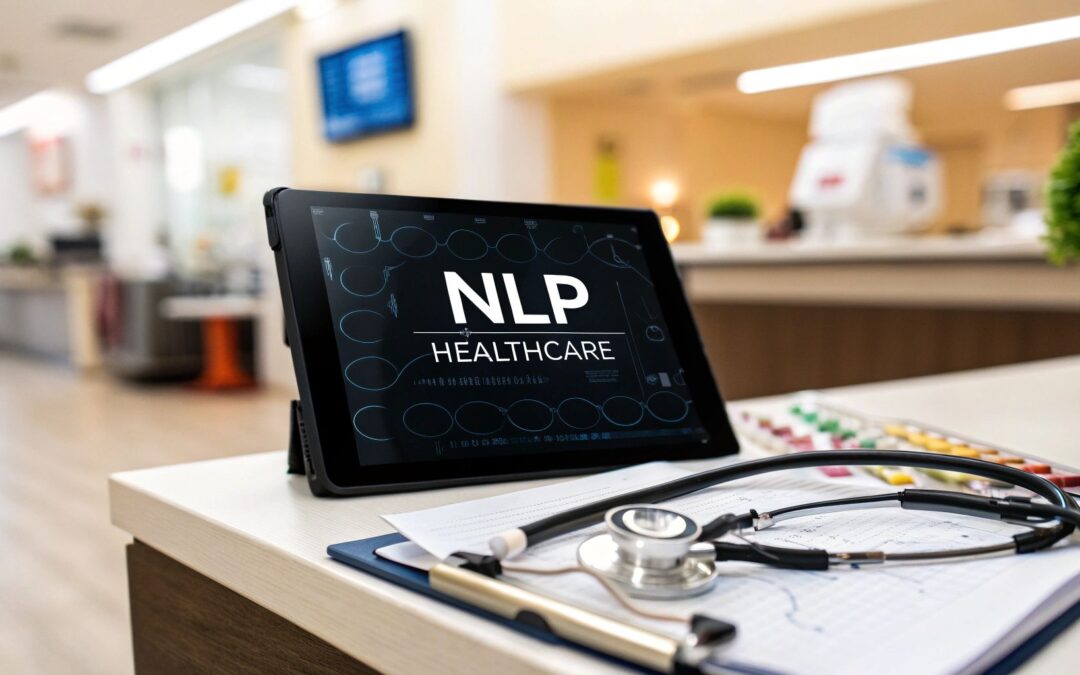Natural language processing is a branch of artificial intelligence that gives computers the ability to read, understand, and even generate human language. In healthcare, this means teaching systems to make sense of the complex world of clinical notes, patient records, and dense research papers.
At its core, NLP is about turning unstructured text—think of a doctor’s free-form dictated notes—into structured data. This process converts messy, narrative information into a clean, organized format that computers can actually analyze, paving the way for massive improvements in both patient care and operational efficiency.
Why Language Is the Next Frontier in Medicine
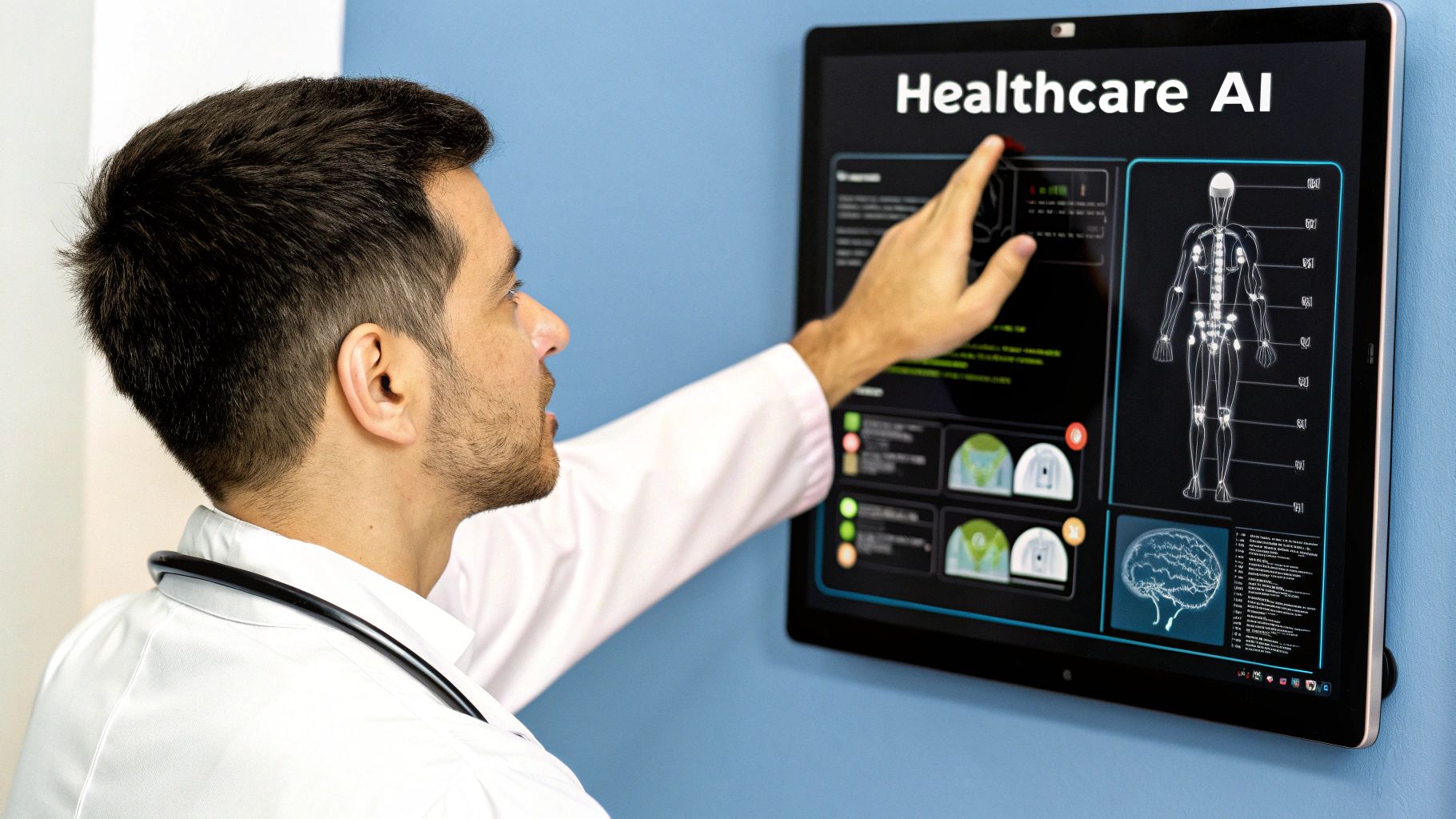
Think about all the patient information that exists. While some of it lives in neat database fields, an incredible 80% of all medical data is unstructured text. This is the human side of medicine: the handwritten physician notes, dictated surgical reports, patient portal messages, and comments on lab results.
This massive text-based archive is a goldmine. It holds the keys to understanding patient health, treatment outcomes, and even emerging public health threats. But trying to analyze it all manually is an impossible task. This is where Natural Language Processing (NLP) comes in. It acts like a super-powered librarian, capable of reading and making sense of that entire collection in a fraction of a second.
Unlocking Hidden Medical Insights
Don't get bogged down by the technical jargon. Think of NLP as a universal translator—a bridge between human language and computer logic. It doesn't just scan for keywords. It digs deeper, deciphering context, spotting relationships between concepts, and pulling out valuable information buried deep within clinical narratives.
By turning messy, unstructured text into clean, organized data, NLP applications in healthcare unlock a level of understanding that was simply out of reach before. It lets us find the signal in the noise.
This ability is a game-changer. It gives healthcare providers the power to make faster, more informed decisions, which ultimately leads to more effective and personalized patient care. The potential applications touch almost every corner of the healthcare world. For example, NLP can:
- Speed up diagnoses by catching subtle symptoms mentioned in a doctor's notes.
- Cut down on administrative work by automatically coding medical records for billing.
- Find the right patients for clinical trials by scanning their medical histories for specific criteria.
- Boost public health efforts by analyzing community health data to spot disease outbreaks early.
As medicine becomes more and more data-driven, being able to act on language-based information is no longer just a nice-to-have; it’s essential.
How NLP Solves Critical Healthcare Challenges
To put it into perspective, the table below shows how NLP directly tackles some of the biggest headaches in the industry today.
| Healthcare Challenge | NLP Solution | Primary Benefit |
|---|---|---|
| Data Overload & Inaccessibility | Extracts and structures key information from clinical notes, reports, and records. | Turns vast amounts of unusable text into actionable, analyzable data. |
| Physician Burnout & Admin Tasks | Automates clinical documentation, summarization, and medical coding. | Frees up clinicians from tedious paperwork to focus on patient care. |
| Inefficient Clinical Trials | Scans patient records to quickly identify and match eligible candidates to trials. | Accelerates research and gets new treatments to patients faster. |
| Reactive Public Health | Monitors and analyzes public health reports and social data for early disease detection. | Enables proactive responses to outbreaks and health trends. |
This is just a glimpse of what's possible. As we dive deeper, we'll see exactly how these solutions are being put into practice to reshape the future of medicine.
How AI Learns to Speak Medicine
For an AI to make sense of the dense, jargon-filled world of medical language, it can't just memorize a dictionary. It has to go through a training process that’s surprisingly similar to how a human medical student learns. This journey is all about turning raw, unstructured text—like a doctor's hurried notes—into organized, actionable information.
Think of it as building knowledge from the ground up. First, the AI learns the basic alphabet and vocabulary of medicine. Then, it has to grasp the grammar—how words and phrases fit together to form coherent clinical statements. Finally, it graduates to understanding semantics, which is all about the subtle context and meaning hidden within a physician's narrative.
This learning curve is steep because medical language is notoriously tricky. A single abbreviation can mean a dozen different things, and a patient’s history is a complex story, not a simple checklist. Natural language processing healthcare models are built specifically to navigate this ambiguity.
From Words to Clinical Concepts
The first step in this education is a process called tokenization. It’s pretty straightforward: the AI just breaks down long sentences into individual words or "tokens." Once it can see the individual words, it moves on to a much more advanced task: Named Entity Recognition (NER).
This is like teaching a student to grab a highlighter and mark up the most important terms in a textbook.
NER models are trained to spot and categorize critical pieces of information buried in a wall of text. For instance, they can pick out:
- Medical Conditions: "hypertension" or "acute myocardial infarction."
- Medications: "atorvastatin 20 mg" or "lisinopril."
- Procedures: "appendectomy" or "coronary artery bypass graft."
- Anatomical Sites: "left ventricle" or "right lower lobe."
This process is what turns a messy paragraph into a structured list of clinical facts. It’s the magic that allows a system to instantly flag a patient's allergies or pull together a complete list of their current medications from pages and pages of notes. Without solid NER, any deeper analysis is dead in the water. For startups in this space, getting this right is non-negotiable, which is why understanding how data annotation is critical for AI is step one.
The image below gives you a high-level look at this journey, from raw text to valuable clinical insights.
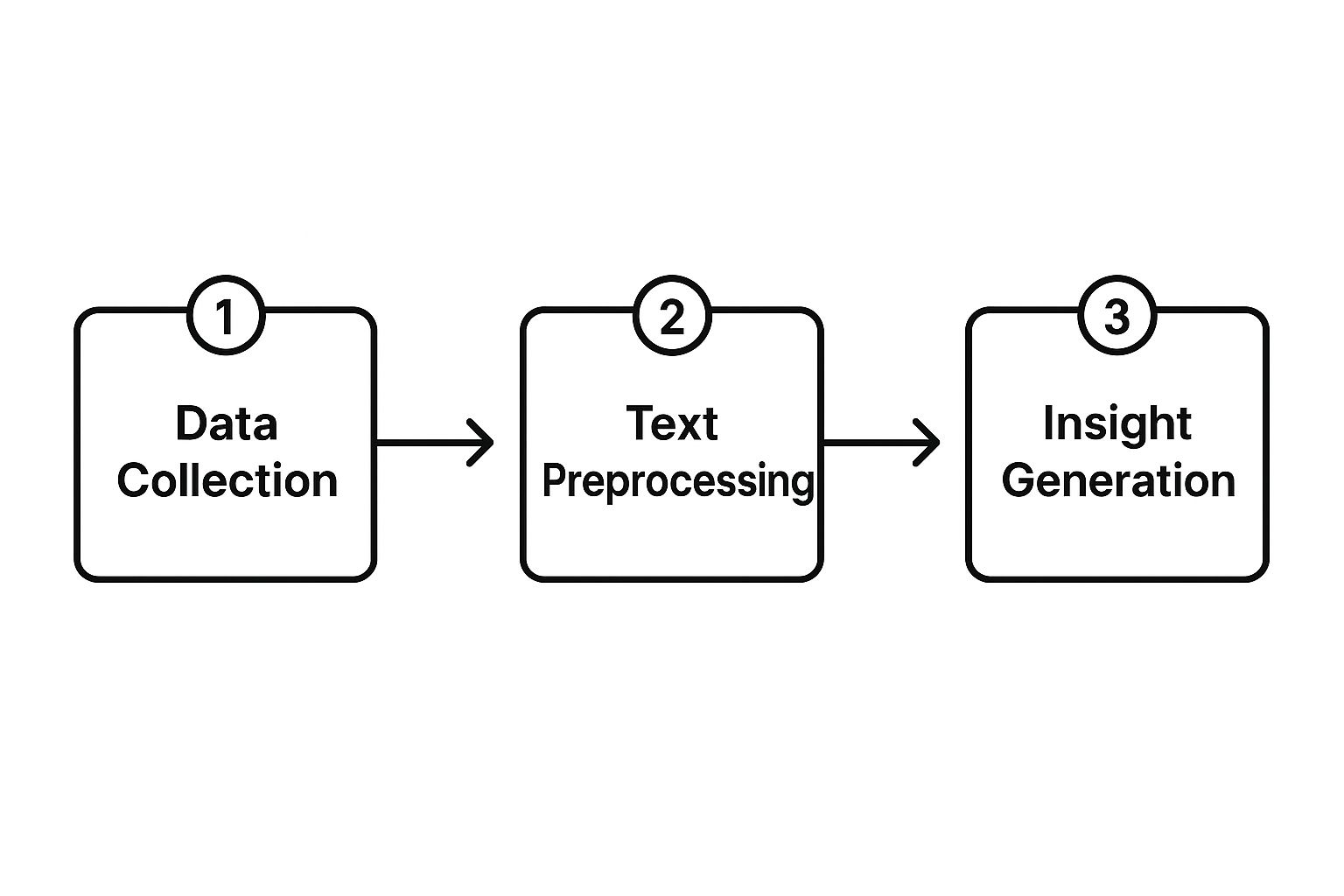
As you can see, raw data gets collected, cleaned up, and then converted into the structured information that can actually drive better healthcare decisions.
Understanding Context and Sentiment
Okay, so the AI can identify key terms. Now what? The next step is learning to understand the relationships between them and the context they live in. A note that says "no signs of pneumonia" is the clinical opposite of one that says "patient shows signs of pneumonia," even though they share the same keywords. This is where the AI really starts to learn the subtleties of medical grammar.
One of the most powerful applications of this is in AI voice recognition in healthcare. These systems have to do more than just transcribe what a doctor says; they need to interpret the clinical meaning behind the words.
Beyond that, NLP can also perform Sentiment Analysis. By looking at patient feedback from surveys or online reviews, it can gauge satisfaction and pinpoint specific areas for improvement.
Sentiment analysis helps organizations move beyond simple star ratings to understand the why behind patient experiences. It can flag specific issues like long wait times or poor communication that need to be fixed.
The rapid adoption of these tools reflects a huge market shift. The global healthcare NLP market is projected to skyrocket from USD 4.87 billion in 2025 to USD 24.45 billion by 2035. This growth is all driven by the urgent need to make sense of the mountains of medical data being generated every day.
By mastering these steps—from recognizing words to interpreting context—AI is finally learning to speak the language of medicine fluently. It’s turning clinical text from a passive record into a powerful tool for improving patient outcomes.
Improving the Patient Journey with NLP
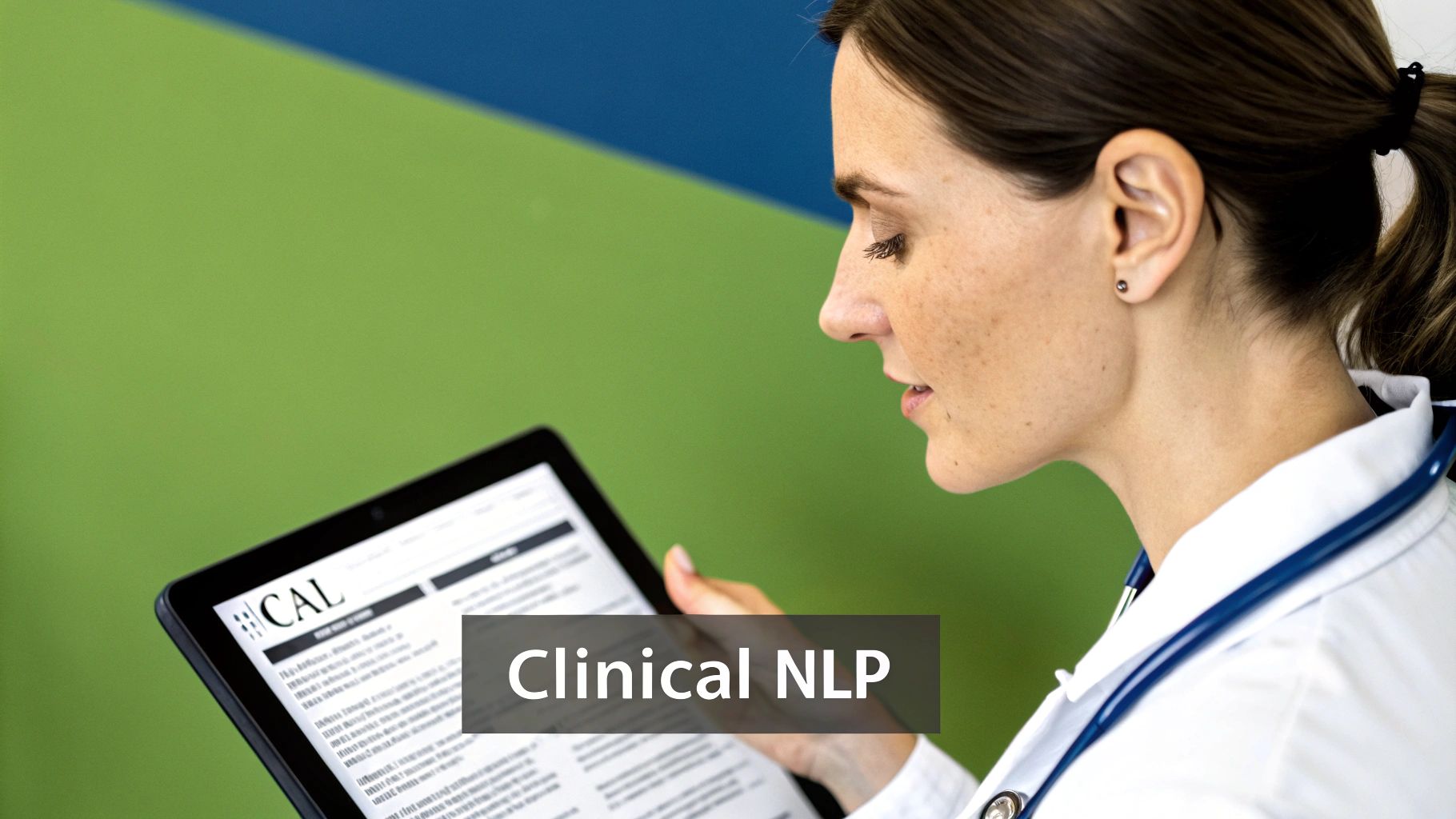
Beyond the data models and complex algorithms, the real test of natural language processing in healthcare is how it affects actual human lives. When applied correctly, NLP isn't just a background process; it becomes an active partner in a patient's care. It directly shapes a better, smoother healthcare experience, from the moment a symptom appears to the final day of treatment.
These tools don’t replace doctors and nurses. Instead, they enhance their skills, giving them a much clearer and more complete picture of a patient's health. The result is faster diagnoses, more personalized care plans, and a system that feels more responsive to everyone involved.
Let’s look at a few real-world scenarios where NLP is already making a huge difference.
Guiding Patients to the Right Care Instantly
Picture this: someone wakes up with a strange rash and a low-grade fever. The old way involved waiting for the doctor's office to open or making a stressful guess about whether an urgent care visit was necessary.
Now, they can just open their provider's app and start a conversation with an AI-powered chatbot.
This isn't just any chatbot. It's powered by sophisticated NLP that allows it to ask smart, relevant questions. It understands descriptions like "itchy red blotches" and "feeling a bit warm," cross-referencing those symptoms with established medical guidelines in real time.
In just a few minutes, the system can determine the issue isn't a true emergency but does need a doctor's attention. It then helps the patient book a same-day virtual appointment, getting them timely medical advice without the anxiety and cost of an unnecessary ER trip.
Predicting Sepsis Before It Becomes Critical
Inside a hospital, every second counts, especially when dealing with a silent killer like sepsis. Sepsis is notoriously tough to catch early because its first signs—like a fever or confusion—can look like a dozen other less serious conditions. This is where NLP acts as a vital safety net.
Think about a patient recovering from a routine surgery. Behind the scenes, an NLP system is constantly scanning their electronic health record (EHR). It reads every new note from a nurse, every lab report, and every observation documented in unstructured text.
The system is trained to spot the subtle combination of signs and risk factors that point to sepsis. It might flag a slight increase in heart rate from one note, a comment about the patient's confusion from another, and a specific lab value buried in a text field. A busy doctor might miss these disconnected clues.
By connecting the dots, the system sends an immediate alert to the clinical team, urging them to investigate for sepsis. This can happen hours before the condition would have escalated into a full-blown crisis, potentially saving the patient's life.
This kind of proactive monitoring shows how NLP can turn a static EHR into an active, life-saving surveillance tool. It finds the critical signals hidden in the noise of clinical notes.
Accelerating Access to Lifesaving Clinical Trials
For a patient with a rare or complex disease, a clinical trial might be their best—or only—option. But finding the right trial has always been a painful, manual process. Researchers can spend months digging through patient records just to find a few eligible candidates.
NLP completely changes the game by automating this matching process. Let’s take the example of someone diagnosed with a rare form of lung cancer.
- The Problem: The patient has a specific genetic marker that makes them a perfect fit for a new therapy being tested in a clinical trial. The problem is, their oncologist may not even know this trial exists.
- The NLP Solution: An NLP algorithm instantly scans the patient's entire medical file, including unstructured text in pathology reports and genomic data. It spots the exact genetic mutation and automatically checks it against a database of active clinical trials.
- The Outcome: The system flags a match and notifies the patient’s care team. The patient gets enrolled in the trial weeks or even months faster than before, giving them access to a treatment that could save their life.
These examples just scratch the surface of NLP's impact. To get a broader view, you can explore our guide on the power of Natural Language Processing, which details its use across many other industries. By truly understanding human language, these systems give clinicians the insights they need to act faster and with greater confidence, fundamentally changing the patient journey for the better.
Powering Hospital Operations and Medical Research
Beyond the patient's bedside, natural language processing in healthcare is fundamentally reshaping the business and science of medicine. It's the engine driving a much-needed overhaul of the administrative and research functions that form the backbone of the entire industry. Think of it as a tool that attacks operational logjams—the very things that eat up resources, inflate costs, and fuel clinician burnout—while simultaneously paving the way for new scientific breakthroughs.
One of the most immediate and tangible impacts of NLP is on clinical documentation. For years, the scene has been the same: physicians spending hours after their shifts dictating or typing up notes. It’s a tedious process that’s become a major source of burnout. NLP-powered tools are flipping that script entirely.
These systems can now listen in on a natural conversation between a doctor and a patient, intelligently picking out and transcribing the critical clinical details. This isn't just simple dictation; it's much smarter. The software can tell the difference between a patient describing their symptoms, the doctor's own observations, and the final diagnosis, converting that conversation directly into a structured, coded entry in the Electronic Health Record (EHR). For any provider looking to cut down on paperwork and reclaim valuable time, exploring specialized dictation software for medical professionals built on this technology is a logical next step.
Getting the Revenue Cycle Right
Another area where NLP is making a huge difference is revenue cycle management. Getting medical coding right is the financial lifeblood of any hospital or clinic, but it's traditionally been a painstaking, manual job prone to human error. A coder has to sift through a patient's entire record to assign the correct billing codes for every diagnosis and procedure.
NLP automates a huge chunk of this process. It scans the clinical notes and suggests the most accurate codes based on what the doctor wrote. It can even spot inconsistencies, like a diagnosis mentioned in a note that was never officially coded, which helps prevent lost revenue and reduces the chance of a claim being denied. This moves the process from a manual grind to an AI-assisted validation, making everything faster and far more precise.
By making sure the billing codes are a perfect reflection of the clinical story, NLP helps healthcare organizations capture the revenue they've earned, stay compliant, and ease the administrative load on their coding teams.
This operational boost is a big reason for NLP's growing adoption. The global market for NLP in healthcare is expected to hit around USD 3.7 billion by 2025, a testament to the incredible efficiency gains from automating data extraction and entry. This automation gives hospital staff back their time, letting them focus on what they do best: taking care of patients.
Speeding Up the Pace of Discovery
NLP’s reach goes far beyond the hospital walls and deep into the world of medical research. The sheer volume of scientific papers published daily is overwhelming; it's physically impossible for any one person to stay on top of it all. This means important findings can easily get buried, slowing down progress.
NLP serves as a tireless digital research assistant. It can tear through thousands of scientific articles, clinical trial reports, and biomedical datasets in the time it takes to drink a cup of coffee. Here’s what that looks like in practice:
- Finding New Drug Interactions: NLP can scan millions of individual case reports to flag previously unnoticed side effects or even beneficial interactions between different drugs.
- Uncovering New Treatment Avenues: It connects the dots between genetic markers, lab results, and patient outcomes across huge populations, pointing researchers toward promising new therapies.
- Synthesizing Existing Knowledge: An algorithm can read decades of research on a single topic and deliver a concise summary, getting scientists up to speed in minutes, not months.
This ability turns a mountain of unstructured text into a searchable, connected web of scientific knowledge. By helping researchers find the right information faster, NLP is dramatically shortening the timeline for getting new, life-saving treatments from the lab to the people who need them. It's a perfect example of how smarter data analysis directly supports better data-driven decision making when the stakes couldn't be higher.
Navigating the Roadblocks to NLP Implementation
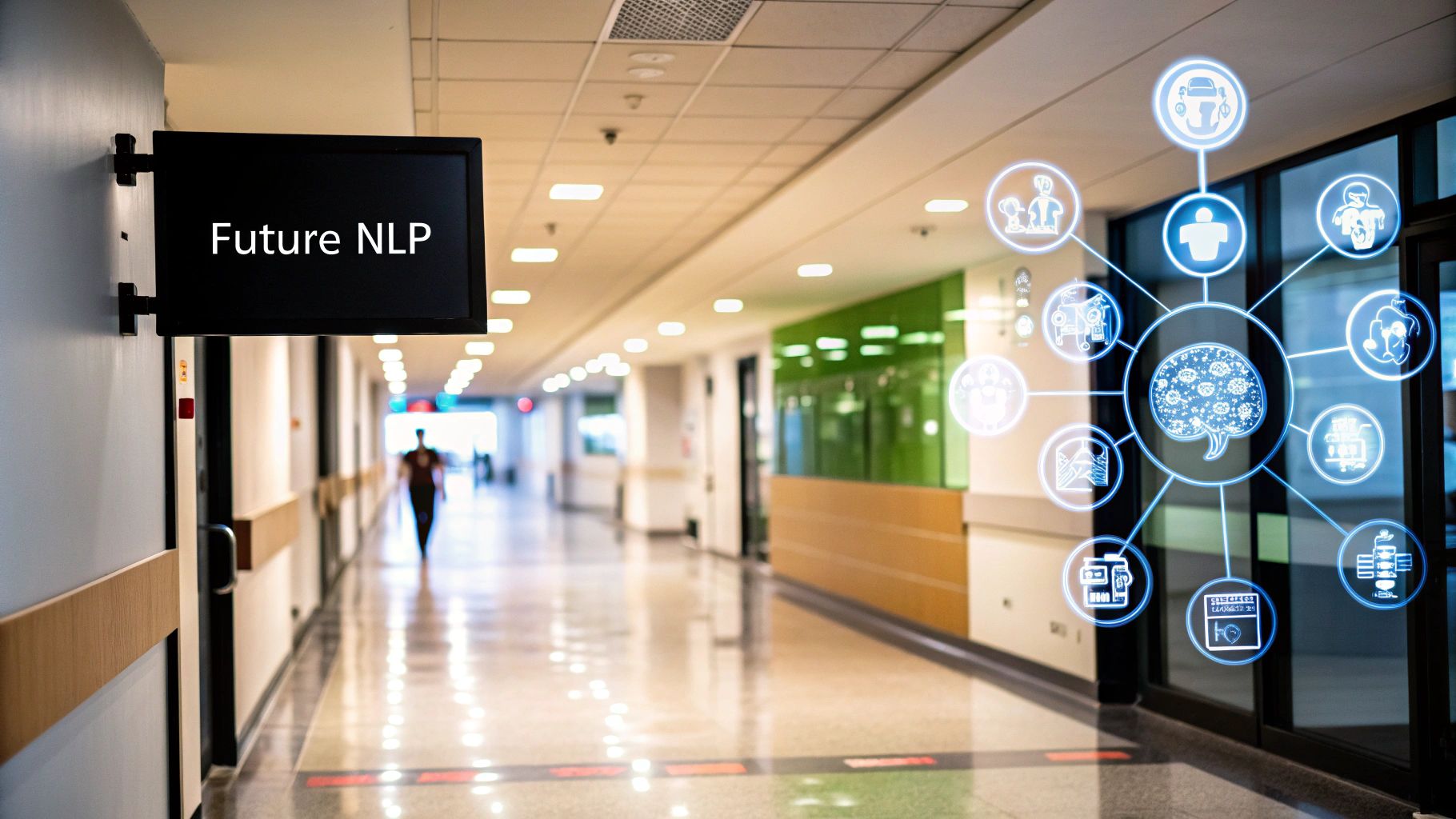
As promising as NLP is, getting it to work in the real world of healthcare is no small feat. It's not a plug-and-play solution. Anyone who tells you otherwise hasn't been in the trenches. The path from concept to successful daily use is filled with potential pitfalls, and you need a solid game plan to navigate them.
The first, and arguably biggest, hurdle is the data itself. An NLP model is like a student—it's only as smart as the material it learns from. The problem is that clinical notes are messy. They’re full of doctor-specific shorthand, abbreviations, and the occasional typo. This "dirty" data can completely throw off an algorithm, leading to unreliable results that nobody can trust.
This is where specialized clinical natural language processing (NLP) becomes so critical. It’s designed to clean up the mess by standardizing and normalizing the information buried in electronic health records (EHRs). By making sense of the chaos, these tools lay the groundwork for accurate analytics and decision support. You can get a deeper dive into the specific role of clinical AI on imohealth.com.
Protecting Patient Privacy and Staying Compliant
In healthcare, you can't just play fast and loose with data. Patient privacy is paramount, and the law—specifically HIPAA—is non-negotiable. Every NLP tool that touches patient information has to be ironclad in its compliance.
This means a rock-solid de-identification process is step one. Before any analysis can happen, all Personally Identifiable Information (PII) must be stripped out. We're talking about scrubbing details like:
- Names and even initials
- Specific dates for birth, admission, or discharge
- Locations smaller than a state
- Phone numbers, email addresses, and other contact info
- Medical record numbers or social security numbers
Skipping this step isn't just a mistake; it's a massive legal and ethical liability. Strong data governance isn't a "nice-to-have," it's the foundation of the entire project.
Weaving NLP into Your Existing Tech Stack
Another common headache is just getting the new technology to talk to the old. Most healthcare systems run on legacy EHR platforms that weren't built with modern AI in mind. Trying to force a new NLP solution into that environment without a smart integration strategy is a recipe for disaster. You end up with data stuck in silos and clunky workflows that just add another layer of frustration for clinicians.
The goal is to make NLP a natural part of the clinical workflow, not another screen to click or system to log into. True success is invisible, embedding insights directly where decisions are made.
The key is to look for solutions that speak a common language. Modern APIs (application programming interfaces), especially those based on Fast Healthcare Interoperability Resources (FHIR), are the gold standard here. Think of FHIR as a universal translator that allows different health IT systems to exchange data smoothly. This is what enables insights from an NLP model to show up right inside the EHR, helping clinicians when and where they need it most. Without that seamless flow, even the most powerful algorithm is just spinning its wheels.
What's Next for NLP in Healthcare?
Natural language processing is quickly moving from the back office to the front lines of medicine. We're past the point where it was just a handy tool for cleaning up data or automating a few tedious tasks. Now, we’re seeing NLP evolve into a genuine partner in clinical decision-making, helping build a healthcare system that's not just more efficient, but fundamentally smarter.
The next wave of innovation is already here, powered by AI models that are bigger and more sophisticated than ever. The point isn’t to replace doctors and nurses, but to give them superpowers—to arm them with critical insights right when they need them most.
The Next Generation of Medical AI
One of the biggest game-changers is the rise of large language models (LLMs) trained exclusively on massive biomedical datasets. Think of it this way: a general AI is like someone who has read the entire internet, while a healthcare-specific LLM is like a specialist who has spent decades studying every medical journal, textbook, and clinical note ever written. This deep specialization means they grasp the subtle nuances of clinical language, leading to far more accurate and relevant results.
This unlocks some incredible new possibilities:
- Real-Time Diagnostic Support: Picture an AI assistant sitting in on a patient visit. As the conversation unfolds, it cross-references the patient’s history and the doctor's notes in real-time to suggest potential diagnoses or flag missing information, acting as an instant second opinion.
- Predictive Health Monitoring: NLP algorithms will soon be able to comb through streams of unstructured data—from patient portal messages to wearable device logs—to spot the early warning signs of a health crisis, like a looming mental health episode or a potential cardiac event.
- Mental Health Insights: By analyzing transcripts from therapy sessions, these advanced models can detect subtle linguistic patterns linked to conditions like depression or PTSD. This gives therapists objective, data-driven feedback to fine-tune their treatment plans.
The real goal isn't just to process information faster; it's to anticipate needs. The future of NLP in healthcare is about delivering predictive, personalized, and preventative insights that amplify, not replace, human expertise.
This shift will make healthcare more intelligent at every turn. As we keep improving how machines understand the messy, complex reality of human language, we get closer to building a system that truly serves both patients and the people who care for them. The mission is simple: use technology to enhance clinical skill, lighten the administrative load, and deliver better outcomes for everyone.
Frequently Asked Questions About NLP in Healthcare
It's natural to have questions when you're looking at bringing a technology like natural language processing into a healthcare setting. Security, practicality, and just getting started are all major considerations. Let's tackle some of the most common questions head-on to clear things up.
The goal here is to answer the practical questions and firm up your understanding of the concepts we've covered.
How Is Patient Data Kept Secure When Using NLP?
Protecting patient data isn't just a priority; it's a fundamental requirement. Any NLP solution worth its salt has to operate within a strict, HIPAA-compliant environment, which involves multiple layers of security.
First, all patient data is scrubbed of personal identifiers before it's ever processed. This is done through robust anonymization and de-identification techniques that remove everything from names and medical record numbers to specific dates.
On top of that, the data is encrypted at all times—both when it's being sent between systems (in transit) and when it's being stored (at rest). Combine that with strict access controls that ensure only authorized staff can view sensitive information, and you have a solid defense. Reputable NLP vendors always back up their security with third-party certifications, so you can verify their protocols.
What Is the Difference Between General and Clinical NLP?
While they both spring from the same AI roots, general and clinical NLP are completely different beasts. It helps to think of it like this: a general NLP model has read the entire internet. It has a massive vocabulary but no real expertise in any one area.
A clinical NLP model, on the other hand, is like a board-certified specialist. It has been meticulously trained on huge volumes of medical literature, millions of clinical notes, and biomedical research.
This specialized training is what makes it safe and accurate for healthcare. It teaches the model the unique language of medicine—the jargon, the complex abbreviations (like "fx" for fracture), and the critical context that a general model would simply miss.
How Can a Hospital Get Started with NLP?
The best way to start is to think small. Don't try to boil the ocean with a vague, all-encompassing "AI strategy." Instead, find one specific, nagging problem and aim your efforts there.
For instance, you could focus on a single pain point, like:
- Easing physician burnout by automating parts of clinical documentation.
- Boosting revenue cycle accuracy by having NLP help with billing codes.
- Making patient intake faster with a smart chatbot.
Pick one clear goal and launch a pilot project around it. This lets you show real, measurable value on a small scale without a massive upfront investment. Working with a vendor who specializes in healthcare NLP can make this a lot easier, as they often have pre-trained models and know how to handle integration. Once you prove the concept and demonstrate a return, you'll have the momentum to scale the solution across the organization.
At Zilo AI, we provide the high-quality data annotation services required to build and train accurate AI models for healthcare. Our expert teams specialize in text, image, and voice annotation, ensuring your systems are ready to tackle real-world clinical challenges. Learn how we can support your AI initiatives at https://ziloservices.com.

